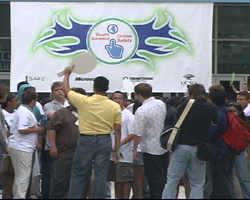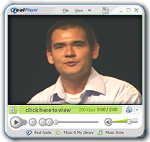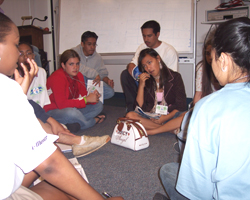UCSD, Calit2 Experts Advise Teens During First Youth Summit for Online Safety
San Diego, CA, June 6, 2005 -- With some 77 million U.S. teens expected to surf the Web this summer, more than 750 high school students from around San Diego packed UCSD's RIMAC arena on June 3 for the first Youth Summit for Online Safety.
|
During the day-long event, two academic experts from the Jacobs School of Engineering and Calit2 participated in a panel discussion with students on subjects such as cyber bullying, phishing, intellectual property, spyware, viruses and other topics related to computing safety, cyber security and cyber citizenship.
The Youth Summit was sponsored by Microsoft, in collaboration with UCSD (and the campus division of Calit2), i-SAFE America (an Internet safety training program), and TakingITGlobal (a global online community for young people). The event was designed to provide teens with the skills they need to help them safely navigate the Internet, and the program was largely interactive. Improv sketches and breakout projects involved the teens themselves in creating online-safety skits, billboards, songs, public-service announcements and more. (The winning team did an American Idol-type skit called Inmate Idol , with High Tech High student Tyrone Lee singing "He Stalks" to a William Hung-style rendition of "She Bangs.")
|
Welcoming the high-schoolers to UCSD, Chancellor Marye Anne Fox noted that the university is conducting research on cyber security and education within the context of Calit2 and two specific projects: ActiveCampus, and the Calit2-led OptIPuter project, which is hooking up high school students at UCSD's Preuss School to large-scale 3D visualizations for an earth-science class. "Computers and computer networks can open up new worlds and new opportunities for you," said Fox. "We have confidence that you will use them effectively and appropriately."
Computer Science and Engineering professor Bill Griswold and Ph.D. candidate Tadayoshi Kohno underscored the vulnerability of home computers at a time when even the most secure government computers have succumbed to hackers. Kohno described his experience as one of the first computer scientists to analyze the safety of electronic voting machines -- which, he found, were extremely vulnerable. "Computer security and online safety is a complex issue," Kohno told the teens. "Many things can go wrong."
|
The researcher noted that information can be vulnerable because of the way a software program is designed or implemented, either on a PC or the web server. "If you go to a library and use a high-speed wireless connection to start instant-messaging a friend about something private, another person in the same library could be listening to the radio waves coming out of your computer," said Kohno. "So even if you do everything reasonably within your power to protect your safety, things can still go wrong, and the problem may be in the software program itself."
Griswold noted the new dimension of online threats from Internet-enabled cell phones that are already offer built-in cameras, mp3 players and games. "The cell phone is not just a communications platform, now it's becoming a computing platform as well," he said. "The next thing cell phones are going to give you is location, and it will let you see the world around you that is just out of sight."
|
Griswold's ActiveCampus project is experimenting with location-based messaging, digital graffiti and other new wireless capabilities based on location awareness. But he warned that along with the new opportunities come new risks. "You'll be able to find your friends, take advantage of nearby shopping opportunities, and all sorts of great things like that," Griswold explained. "But that also means you may be at risk not just from online stalking, but from stalking in the physical world, from someone who knows your location. And the time of transition from cyber to physical threat is not a matter of hours or days, but a matter of seconds."
Some experts said teens use technology differently than do adults, who generally view computers as tools for business, rather than as a social enabler. As a result, teens approach interactions with fewer defenses, making them more vulnerable to online threats.
"It is an interesting paradox; while teens are vulnerable, they also are very savvy users of technology," said Susan Koehler, senior director of consumer safety at Microsoft. "With the right knowledge and awareness, they have the potential to be a huge part of the solution when it comes to making the Internet safer."
|
The summit included a strong call to action for teens to not only use the Internet wisely, but also to pass along the safety message to friends and family. The Jacobs School's Kohno said one simple lesson should be about password selection. "I suspect that many people here have passwords that are related to a member in their family, their dog, or their birthday," he noted. "That is a bad choice. If someone has a little bit of information about you, they may be able to get access to things that you prefer to keep protected."
The only grumbling from students during the event came when a few of them heckled a representative from the Motion Picture Association of America, who participated in the panel discussion to warn against online piracy. A related poll -- with students using an electronic system that tabulated the votes instantly -- showed that 82 percent of the students have downloaded music or movies from the Web.
Related Links





